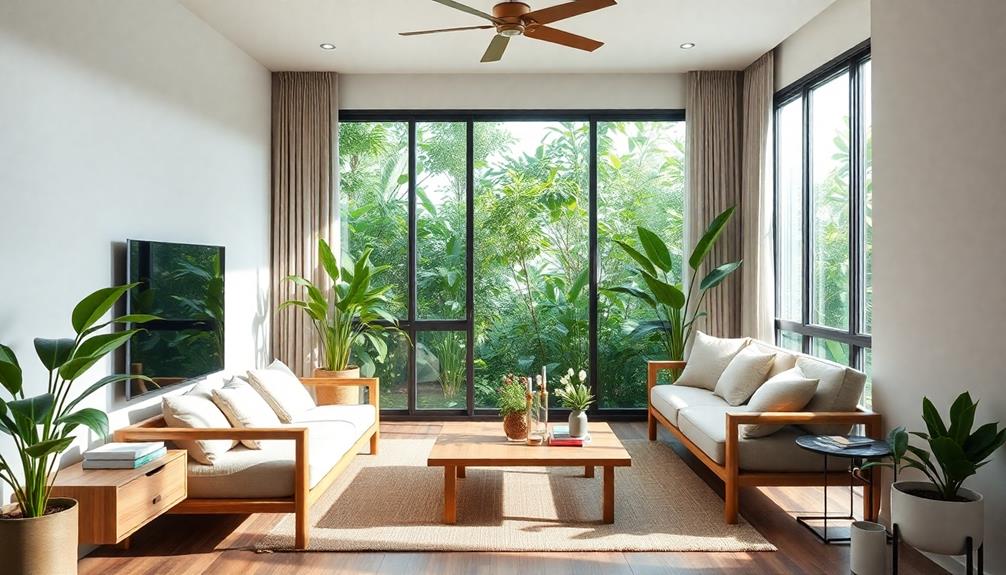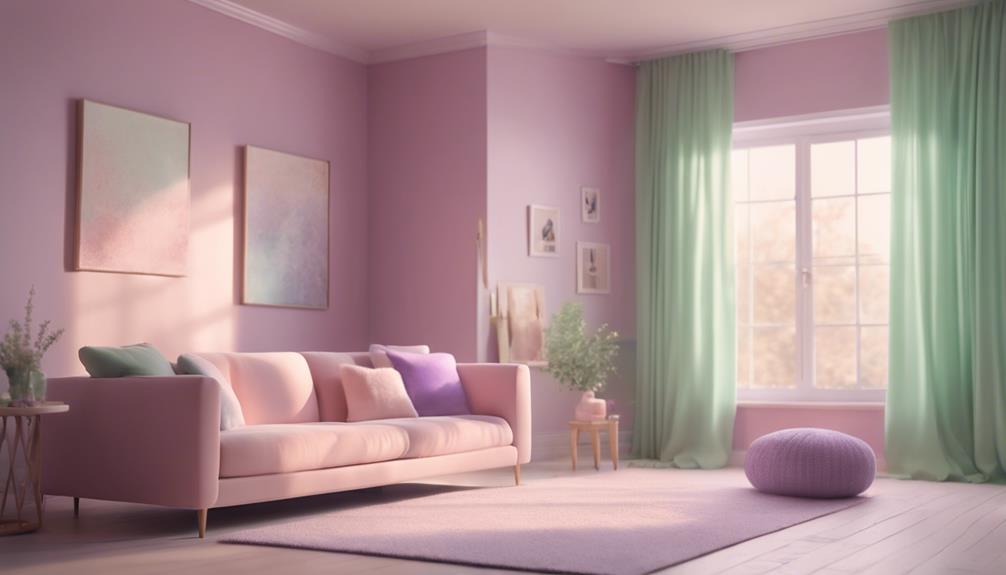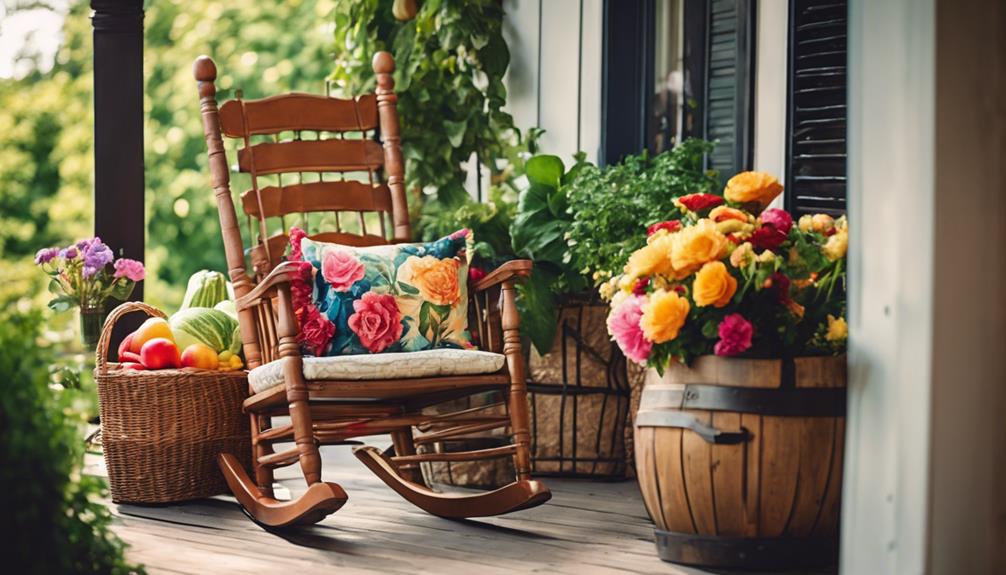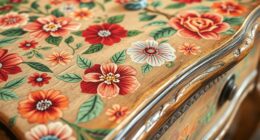To achieve a chic minimalist Indonesian design in your small space, focus on simplicity and natural elements. Use a light, neutral color palette to create an airy feel and enhance brightness. Opt for materials like bamboo and rattan to retain that warm, organic vibe. Maximize your storage with multipurpose furniture and vertical shelving, keeping things tidy and functional. Incorporate mirrors to reflect light, making the area appear larger. Finally, don't forget to add greenery with low-maintenance plants for tranquility. There's plenty more to explore, so keep going to uncover additional stylish tips for your home.
Key Takeaways
- Utilize light and neutral color palettes to promote openness and reflect natural light, enhancing the airy feel of small spaces.
- Incorporate multipurpose furniture to maximize utility and reduce clutter while maintaining a stylish aesthetic.
- Optimize vertical space with wall-mounted shelves and tall cabinetry to keep the floor clear and enhance organization.
- Embrace natural materials like bamboo and rattan, reflecting Indonesian design heritage while adding warmth to the environment.
- Integrate greenery through low-maintenance plants and vertical gardens to create a calming connection with nature in small spaces.
Importance of Minimalist Design
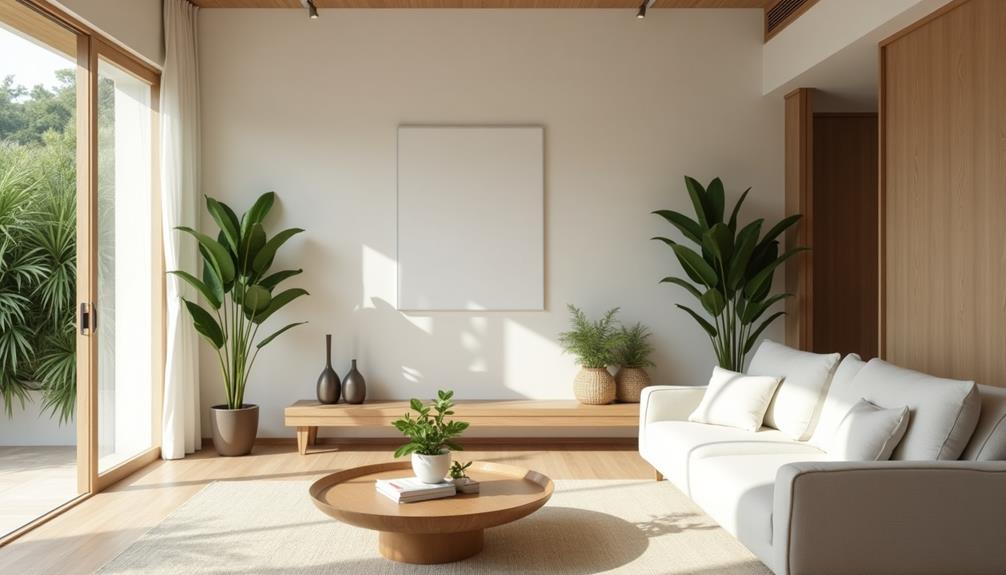
While you might think that filling a space with furniture and decor enhances its appeal, minimalist design actually proves otherwise. In small spaces, embracing a minimalist approach creates a sense of openness that allows for better movement and improved functionality. By integrating natural materials and earth tones, reminiscent of Balinese Interior Design, you'll create a soothing atmosphere that complements the minimalist aesthetic.
By reducing clutter, you'll promote mental clarity, enabling you to focus on the essential elements of your environment. Minimalist design encourages mindful consumption of space and resources, which is crucial for sustainable living. When you choose to keep only what truly matters, you'll find that your small space becomes more organized and serene.
This atmosphere not only enhances your quality of life but can also positively impact your overall well-being. Incorporating effective storage solutions within a minimalist framework is key. You can maximize vertical space or utilize multipurpose furniture to keep your belongings tucked away, preserving the openness of your living area.
Additionally, a well-executed minimalist aesthetic can enhance your property value, making your space more appealing to potential buyers or renters. Ultimately, minimalist design isn't just about aesthetics; it's a lifestyle choice that fosters clarity, functionality, and sustainability in your small space.
Optimal Color Palette Choices
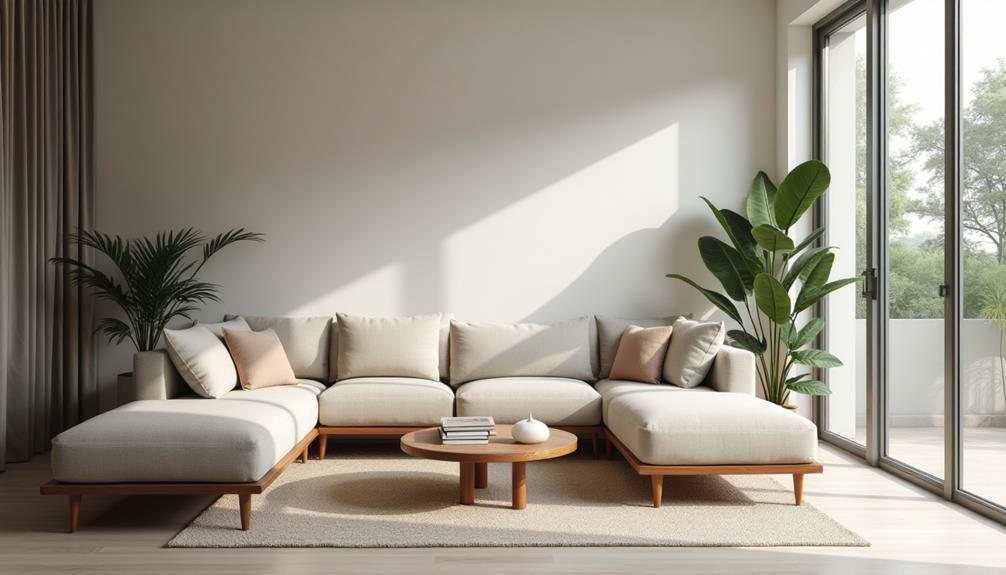
Choosing the right color palette is essential for achieving a chic minimalist Indonesian design. Light colors like soft whites and light greys are perfect for small spaces, as they reflect natural light and create an airy feel.
These neutral colors not only enhance the sense of openness but also help maximize your storage space by visually decluttering the environment. Incorporating elements such as traditional artistry can add a unique touch that celebrates the rich Indonesian culture without overwhelming the minimalist aesthetic.
Incorporating pastel shades can add subtle warmth and character to your interiors without overwhelming the senses. This approach keeps your space cozy while adhering to minimalist principles.
If you want to create visual interest, consider adding an accent wall in a deeper hue. This can serve as a focal point, enriching the overall aesthetic while maintaining simplicity.
A cohesive color palette featuring varying shades of the same color can unify different elements within a room, contributing to a calming atmosphere.
Additionally, using lighter colors on the ceiling can make your rooms appear taller and more open. This not only enhances the visual height but also complements your minimalist efforts in optimizing every inch of your small Indonesian home.
Embrace these color choices to elevate your space effortlessly.
Selecting Suitable Materials
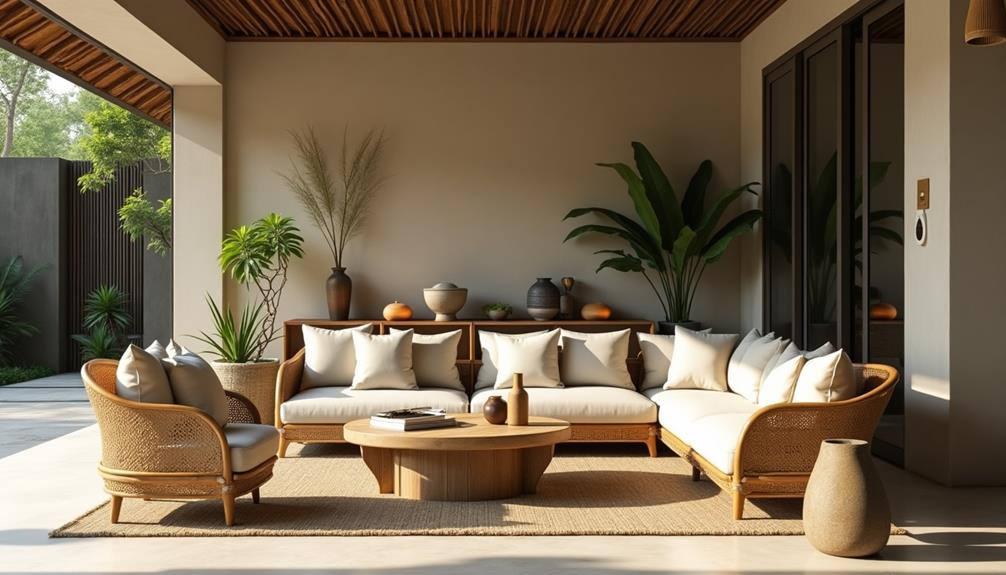
When it comes to selecting suitable materials for your chic minimalist Indonesian design, prioritize lightweight and sustainable options like bamboo and rattan. These materials not only contribute to a warm and inviting atmosphere but also align with the minimalist aesthetic, making your small space feel more open and airy.
Incorporating elements like Indonesian Decorative Pillows can further enhance the comfort and style of your space.
Incorporate sheer drapes made from natural fibers to enhance brightness and create an illusion of spaciousness without overwhelming the design. For furniture, opt for transparent materials such as acrylic or glass; they maintain clean lines and an open feel while adding a touch of elegance.
Don't forget to utilize robust textures, like teak or reclaimed wood, which resonate with Indonesian design heritage and add depth to your space. Additionally, select materials that reflect light, such as polished surfaces or metallic accents. These choices can enhance the perception of space and sophistication, making your small area feel larger.
Lastly, consider how your materials can provide storage solutions without compromising on style. By carefully selecting suitable materials, you can create a harmonious and functional environment that embodies chic minimalist Indonesian design.
Utilizing Mirrors and Light
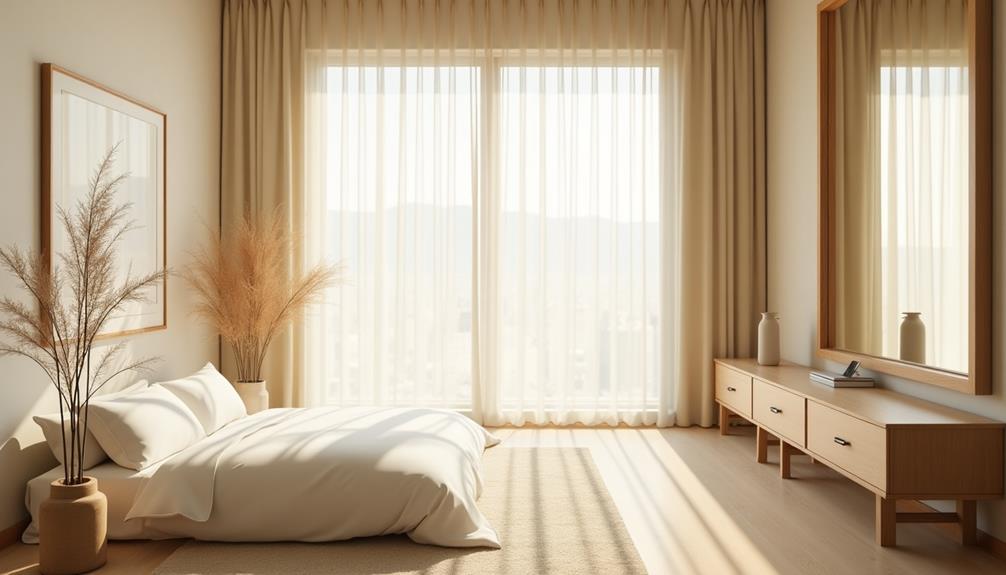
To create a bright and spacious feel in your Indonesian home, strategically place mirrors near windows or in corners to reflect natural light. This not only maximizes illumination but also enhances the room's depth and dimension, making it appear larger.
Incorporating natural materials like wood or bamboo in your decor can further complement the light reflections, creating a harmonious atmosphere that resonates with traditional Indonesian style.
Pairing these reflective surfaces with light colors will amplify the airy vibe that's essential to chic minimalist design.
Reflective Surface Strategies
Incorporating reflective surfaces into your minimalist Indonesian design can dramatically enhance the light and space in your home. By strategically placing mirrors opposite windows, you can maximize natural light reflection, making small spaces feel brighter and more expansive. Wall-mounted mirrors enhance depth and dimension, creating an illusion of greater space when positioned thoughtfully.
Consider these reflective surface strategies:
| Strategy | Benefit |
|---|---|
| Large standalone mirrors | Serve as focal points and expand space |
| Wall-mounted mirrors | Add depth and enhance light distribution |
| Mirrored sliding doors | Save space while reflecting light |
| Glass furniture | Amplify brightness and airy feel |
| Metallic accents | Enhance overall light distribution |
These techniques not only improve the aesthetic of your interiors but also contribute to a more open atmosphere. By incorporating reflective surfaces, you'll find that your home feels more inviting and spacious, even in the smallest areas. So, embrace these strategies to create a chic and minimalistic sanctuary that feels expansive and full of light!
Natural Light Maximization
Maximizing natural light in your home can transform your space into a bright and inviting oasis. One of the best ways to achieve this is by strategically using mirrors.
Position mirrors opposite windows to reflect sunlight, creating a brighter atmosphere that feels more spacious. Large wall-mounted mirrors not only amplify the available light but also add depth to small spaces. Incorporating elements like Indonesian decor masks can enhance the aesthetic while celebrating rich cultural heritage.
To further enhance the effect, consider these tips:
- Incorporate decorative mirrors: Stylish frames can serve as focal points while reflecting natural light, aligning with a minimalist aesthetic.
- Layer your lighting: Combine ambient, task, and accent lighting to complement the natural light source. This reduces shadows and enhances the airy feel in your home.
- Choose sheer window treatments: These allow maximum light penetration, maintaining privacy while creating a cozy environment.
Innovative Storage Solutions
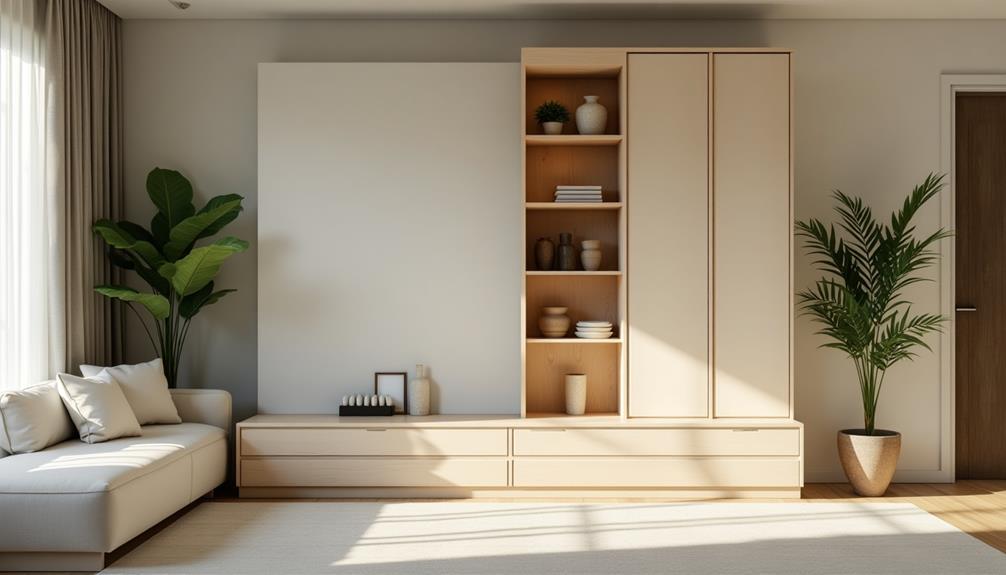
When it comes to maximizing space in your minimalist Indonesian home, innovative storage solutions are key.
Incorporating elements of traditional Indonesian housing can inspire unique designs that reflect your cultural heritage while enhancing functionality.
Consider multi-functional furniture like ottomans that serve as both seating and storage, while vertical techniques such as floating shelves can keep your floor area open and airy.
Don't overlook hidden storage options, like under-bed drawers, which can help maintain a clean and organized feel without sacrificing style.
Multi-Functional Furniture Options
With the increasing demand for functional living spaces in Indonesia, multi-functional furniture is a game-changer for small homes. By opting for pieces that serve dual purposes, you can maximize usability without sacrificing style.
Luxury tropical designs often incorporate these elements, ensuring that each piece contributes to an inviting atmosphere. Here are some design tips to contemplate:
- Ottomans with hidden storage: These can provide seating while concealing clutter, perfect for tight areas.
- Sofa beds: Ideal for accommodating guests without needing an extra room, they effortlessly blend comfort and functionality.
- Coffee tables with drawers: These offer a stylish surface while keeping your living space tidy.
Incorporating built-in storage solutions, like benches with compartments, not only reduces clutter but also enhances your minimalist aesthetic.
Choosing modular furniture allows you to rearrange layouts easily for different occasions, making it adaptable to your needs. Additionally, selecting pieces with legs can create an airy feel, allowing light to flow underneath and making your small spaces appear larger.
Vertical Storage Techniques
Transforming your small living space into an organized haven often hinges on clever vertical storage techniques. Start by utilizing wall-mounted shelves to free up floor space while providing ample storage for books and decor. This not only enhances the aesthetic of your home but also keeps clutter at bay.
Incorporating elements from luxury tropical designs can further elevate your space, making it both functional and visually appealing.
Consider installing tall cabinetry that reaches the ceiling, maximizing storage without sacrificing valuable floor area. This allows you to create organized spaces that feel spacious and tidy.
Don't forget about multi-functional furniture; benches or ottomans with built-in storage can combine seating with functional solutions, perfect for small spaces.
You can also use hooks and pegboards on your walls to hang items like bags or kitchen utensils. This keeps frequently used items accessible while maintaining a minimalist look.
Lastly, think outside the box by incorporating under-stair storage solutions, such as built-in drawers or open shelving. These often-overlooked spaces can become invaluable for keeping your living area organized.
Hidden Storage Solutions
Hidden storage solutions are essential for maximizing space in a minimalist Indonesian design. By incorporating clever storage options, you can keep your small spaces organized while maintaining a chic aesthetic.
Reflect on integrating elements of Indonesian Wedding Decor, such as vibrant colors and intricate fabrics, into your storage solutions to enhance visual appeal. Here are some innovative ideas to ponder:
- Built-in benches or ottomans with hidden compartments for storing blankets and magazines.
- Under-bed storage solutions like rolling drawers or boxes for seasonal clothing and shoes.
- Floating shelves that not only display decorative items but also hide storage in baskets or boxes.
Utilizing multi-functional furniture can greatly enhance your space. Coffee tables with lift-tops or sofas with storage underneath help keep your environment clutter-free while providing practical utility.
Additionally, reflect on designing custom cabinetry that reaches the ceiling. This not only creates extra storage but also eliminates dust traps, ensuring a clean and streamlined look.
Furniture Selection Tips
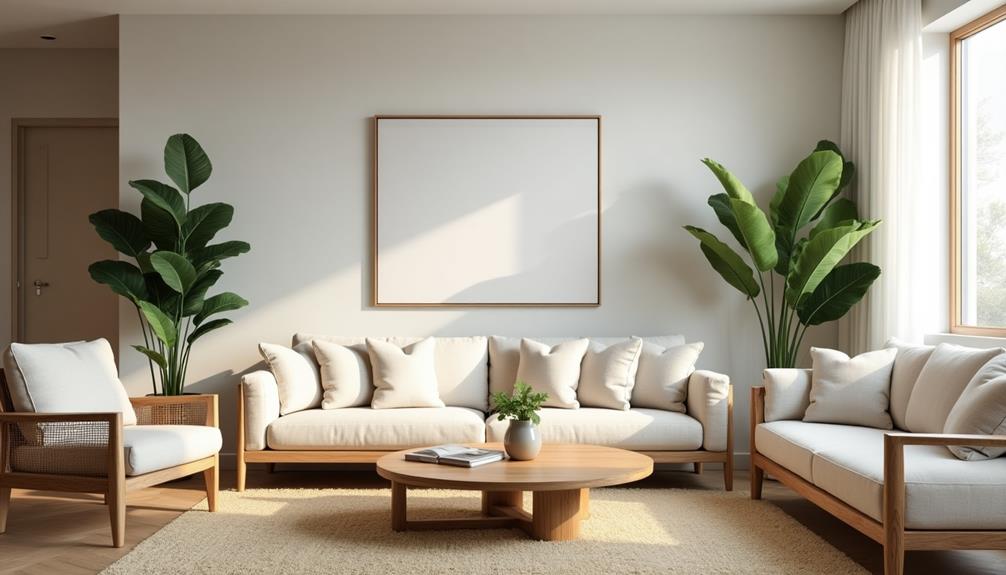
When it comes to selecting furniture for a chic minimalist Indonesian space, prioritize pieces that serve multiple purposes. Multi-functional furniture, like a sofa bed or an ottoman with storage, can help you maximize utility while keeping clutter at bay. This approach is essential in small spaces where every bit of functionality counts.
Consider incorporating elements such as intricate wooden carvings, which can add a touch of traditional style while maintaining a minimalist feel traditional decor ideas.
Opt for lightweight furniture with legs, as it creates an airy feel and allows light to flow freely, making your area appear larger. Streamlined designs with simple lines and neutral colors will also contribute to a cohesive minimalist aesthetic, ensuring your space remains visually appealing.
Investing in modular furniture is a smart choice, too. These adaptable pieces can be easily rearranged to accommodate various activities and needs, increasing the flexibility of your small living area.
Additionally, consider built-in storage solutions like wall-mounted shelves or custom cabinetry, which help optimize vertical space and keep your floor area open and organized.
Maximizing Natural Light
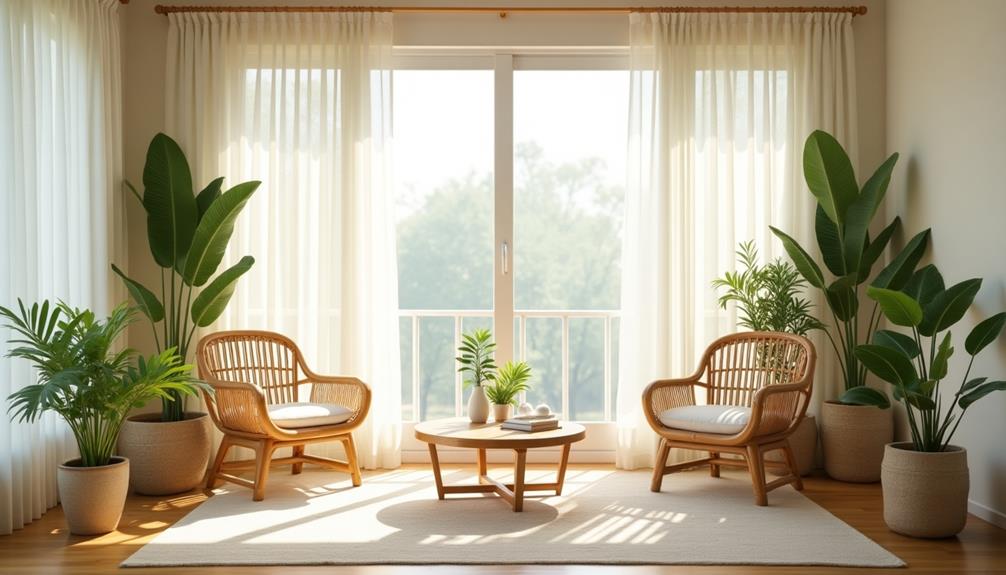
To create a truly inviting minimalist Indonesian space, maximizing natural light is key. Start by incorporating large windows and sliding glass doors, allowing ample natural light to flood your small spaces. This creates an airy and open atmosphere that feels welcoming.
To enhance the brightness further, consider these tips:
- Use light-colored walls to reflect more light, making the room feel more spacious.
- Install light-filtering sheer curtains to soften the harsh sunlight while still allowing plenty of natural light to brighten your interior.
- Position mirrors opposite windows to reflect and amplify the natural light, effectively enlarging the space visually.
Additionally, don't forget about artificial lighting. Strategically placed wall sconces and recessed lights can complement the natural light, ensuring your space remains bright even at night.
Layout and Space Utilization
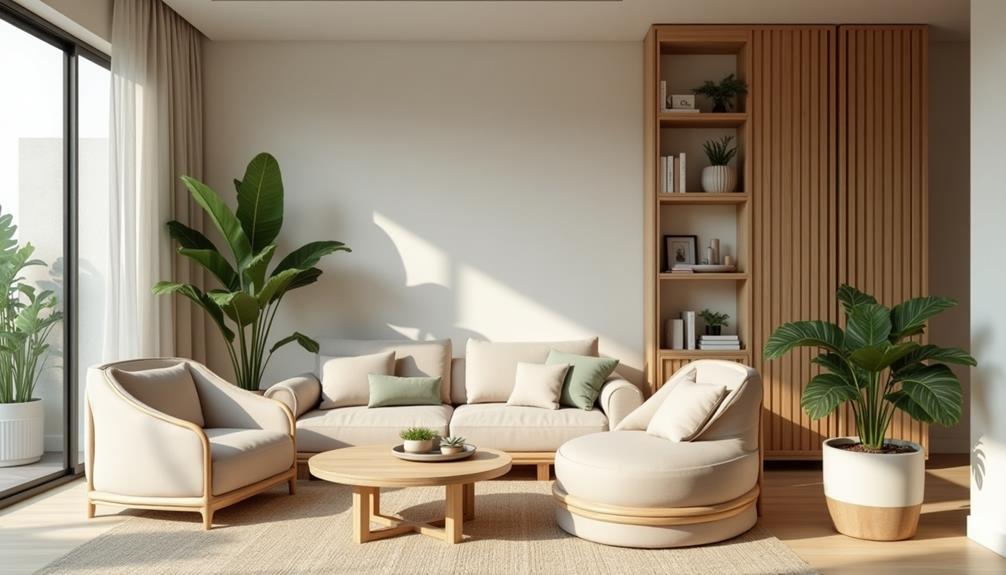
Creating an inviting minimalist Indonesian space hinges on thoughtful layout and effective space utilization. In small spaces, it's crucial to avoid pushing furniture against walls. Instead, maintain a gap to prevent a cramped feel and promote an open environment. Experiment with negative space by leaving empty areas, enhancing the perception of spaciousness.
You can strategically angle furniture to create visual interest and improve flow, making tight areas feel less confined. Additionally, utilize vertical storage solutions like wall-mounted shelves to free up floor space, enhancing organization. Select furniture that elevates off the ground, which contributes to a sense of openness and airiness in your compact living areas.
Here's a quick guide to optimize your layout and space utilization:
| Tip | Description |
|---|---|
| Keep Space Between Furniture | Avoid a cramped feel by maintaining gaps. |
| Embrace Negative Space | Leave empty areas to enhance spaciousness. |
| Angle Your Furniture | Create visual interest and improve flow. |
| Use Vertical Storage | Free up floor space with wall-mounted shelves. |
| Choose Elevated Furniture | Promote openness with furniture that serves. |
Incorporating Nature and Greenery
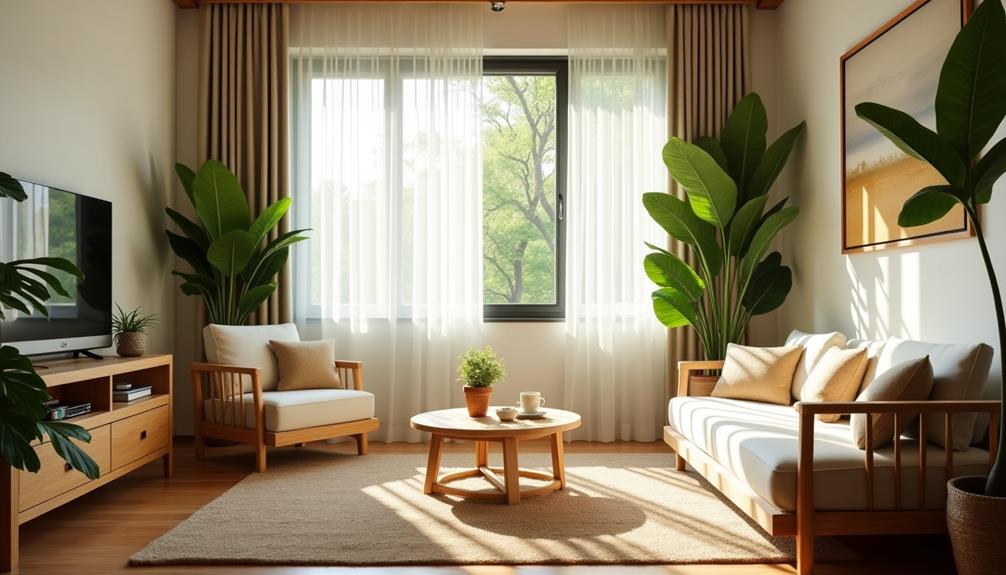
Bringing nature indoors can transform your minimalist Indonesian space into a serene retreat. By incorporating indoor plants, you not only enhance air quality but also create a calming atmosphere that fits perfectly in small spaces.
Consider these ideas to seamlessly integrate greenery into your home:
- Vertical gardens: Utilize wall planters to add lush greenery without taking up valuable floor area.
- Natural materials: Choose bamboo or rattan plant pots that harmonize with your minimalist design and reflect traditional Indonesian elements.
- Strategic placement: Position plants near windows to maximize natural light, boosting both plant growth and the overall brightness of your space.
Opt for low-maintenance plants, like snake plants or succulents, which require minimal care and thrive in urban settings.
By thoughtfully incorporating indoor plants, you'll create a revitalizing ambiance that not only enhances your decor but also ties your living space to the natural world.
Embrace the beauty of greenery and let your small space reflect a tranquil, chic lifestyle.
Frequently Asked Questions
How to Use Minimalist Design in Small Areas?
To use minimalist design in small areas, you'll want to choose light colors, multi-functional furniture, and strategic mirrors. Keep layouts open, use vertical storage, and avoid oversized pieces to enhance space and functionality.
How to Make a Small Room Look Minimalist?
To make a small room look minimalist, choose light colors, use multi-functional furniture, and keep the layout open. Incorporate mirrors for depth, and opt for sheer curtains to enhance natural light and maintain privacy.
How to Make a Small Space Look Expensive?
To make your small space look expensive, incorporate high-quality materials and a cohesive color palette. Choose multi-functional furniture, use mirrors to enhance depth, and add statement decor to create an elegant and sophisticated atmosphere.
How Do Interior Designers Make Small Rooms Look Bigger?
You might think small rooms are hopeless, but interior designers cleverly use light colors, mirrors, and strategic furniture placement. They maximize vertical storage and maintain consistent flooring to create an illusion of spaciousness and openness.
Conclusion
By embracing chic minimalist design in your small space, you're not just creating a stylish environment; you're also boosting your well-being. Did you know that a clutter-free space can increase productivity by up to 30%? With thoughtful color choices, innovative storage solutions, and a dash of greenery, you can transform your home into a serene oasis. So, take these tips to heart and enjoy the benefits of a beautifully organized, minimalist lifestyle!
